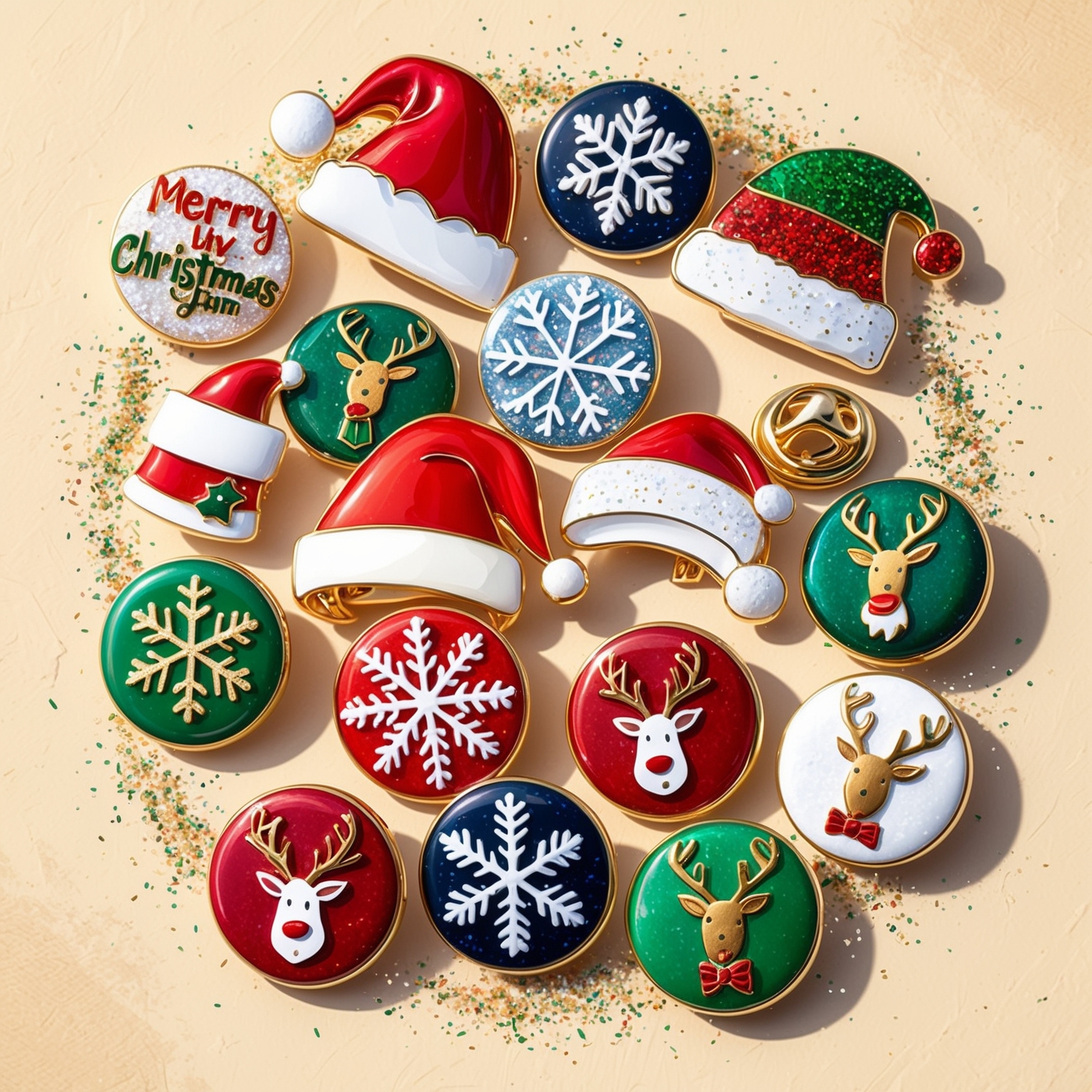Lapel pins have long served as symbols of honor, achievement, and affiliation. From military decorations to corporate recognition and sports accolades, lapel pins encapsulate significant moments and accomplishments in a compact, wearable form. This article explores the art and strategy behind designing lapel pins that commemorate milestone moments, providing insights into the design process, materials, customization options, and the emotional impact these small tokens can have. Whether you are an organization looking to recognize achievements or an individual seeking to commemorate personal milestones, this guide will help you create lapel pins that honor and remember special achievements.
Lapel pins are powerful tools for recognition and commemoration. They offer a tangible way to celebrate achievements, mark special occasions, and foster a sense of belonging and pride. The process of designing lapel pins that effectively capture and convey the significance of milestone moments involves creativity, attention to detail, and an understanding of the emotions and values associated with the achievement.
This article will delve into the various aspects of designing lapel pins, from the initial concept and design elements to material selection, customization options, and production techniques. We will also explore the psychological and emotional impact of lapel pins, providing practical tips and real-life examples to inspire your own pin designs.
The Importance of Lapel Pins in Recognizing Achievements
Symbolism and Significance
Lapel pins serve as symbols of achievement and recognition, representing hard work, dedication, and success.
- Historical Context: The tradition of using pins and badges to signify accomplishments dates back centuries. Military medals, scout badges, and academic pins are just a few examples of how pins have been used to honor achievements.
- Emotional Impact: Receiving a lapel pin can evoke a strong emotional response, providing a sense of validation, pride, and belonging. Pins serve as a constant reminder of the achievement and the effort it took to reach that milestone.
- Visibility and Wearability: Lapel pins are wearable symbols that can be displayed on clothing, bags, and accessories. This visibility allows recipients to share their accomplishments with others and fosters a sense of community and recognition.
Applications in Various Sectors
Lapel pins are used across different sectors to recognize a wide range of achievements and milestones.
- Corporate Recognition: Companies use lapel pins to acknowledge employee achievements, such as years of service, outstanding performance, and special contributions. These pins can boost morale, increase motivation, and foster loyalty.
- Educational Institutions: Schools and universities award lapel pins to recognize academic achievements, leadership, and participation in extracurricular activities. Pins can also commemorate graduation and other significant milestones.
- Sports and Athletics: Sports organizations use lapel pins to celebrate team victories, individual achievements, and participation in tournaments and events. Pins are often traded and collected as mementos.
- Nonprofits and Community Organizations: Nonprofits use lapel pins to honor volunteers, donors, and supporters. These pins serve as tokens of appreciation and help build a sense of community and commitment.
Designing Lapel Pins: The Process and Considerations
Concept Development
The first step in designing a lapel pin is developing a concept that reflects the achievement and resonates with the intended recipients.
- Understanding the Purpose: Clearly define the purpose of the pin and the achievement it represents. Consider the values and emotions associated with the milestone and how they can be conveyed through the design.
- Target Audience: Consider the preferences and expectations of the target audience. The design should appeal to the recipients and reflect their interests and affiliations.
- Theme and Symbolism: Choose a theme and symbols that represent the achievement. Common themes include excellence, leadership, teamwork, and dedication. Symbols such as stars, laurel wreaths, and torches can be used to convey these themes.
Design Elements
Designing lapel pins involves various elements that contribute to the overall look and feel of the pin.
- Shape and Size: The shape and size of the pin should complement the design and be appropriate for its intended use. Common shapes include circles, squares, shields, and custom shapes that reflect the theme.
- Color Scheme: Choose a color scheme that aligns with the organization’s branding and the achievement being recognized. Colors can convey different emotions and meanings, so select hues that enhance the design’s impact.
- Imagery and Icons: Incorporate imagery and icons that symbolize the achievement. These elements should be clear and recognizable, even at a small size. Consider using high-contrast colors and bold lines to ensure visibility.
- Text and Typography: Add text to convey specific information, such as the name of the award, the recipient’s name, or the date of the achievement. Choose legible fonts that complement the overall design.
Material Selection
The choice of materials plays a crucial role in the quality and appearance of the lapel pin.
- Metal Options: Common metals used for lapel pins include brass, copper, iron, and zinc alloy. Each metal has its own characteristics in terms of weight, durability, and finish.
- Plating and Finishes: Plating options include gold, silver, nickel, copper, and black nickel. Finishes can be polished, matte, antique, or brushed, each providing a different aesthetic effect.
- Enamel Types: Soft enamel and hard enamel are popular choices for adding color to lapel pins. Soft enamel has a textured surface, while hard enamel is smooth and polished. Both options offer vibrant colors and durability.
Customization and Personalization
Customization adds a unique and personal touch to lapel pins, making them more meaningful for recipients.
- Personalized Text: Include personalized text, such as the recipient’s name or the specific achievement, to make the pin unique. This can be done through engraving or printing.
- Custom Shapes: Design custom shapes that reflect the theme or organization. Custom shapes can make the pin stand out and add a unique element to the design.
- Special Features: Consider adding special features, such as 3D elements, cutouts, spinners, or danglers. These features can enhance the visual appeal and uniqueness of the pin.
Production Techniques
Understanding the production techniques used to create lapel pins can help ensure the final product meets your expectations.
- Die Struck: Die struck pins are created by stamping the design into metal, creating a raised and recessed pattern. This technique is ideal for intricate designs and offers a high-quality finish.
- Cloisonné: Cloisonné pins use a process similar to enameling, where colored glass paste is applied to recessed areas and fired to create a smooth, durable surface. This technique is known for its vibrant colors and fine details.
- Offset Printing: Offset printing allows for detailed and full-color designs to be printed directly onto the pin. This technique is suitable for designs with gradients, complex imagery, and photographs.
- Laser Engraving: Laser engraving is used to add precise and permanent text or designs to the pin. This technique is often used for personalization and adding fine details.
Case Studies: Designing Lapel Pins for Special Achievements
Case Study 1: Corporate Employee Recognition
Background
A leading tech company wanted to recognize employees who had achieved significant milestones, such as five, ten, and fifteen years of service. The goal was to create a series of lapel pins that celebrated their dedication and contribution to the company.
Design Process
- Concept Development: The company chose a theme of growth and progress, symbolized by a tree with roots and branches. Each milestone year was represented by different stages of the tree’s growth.
- Design Elements: The pins were designed in a circular shape, with the tree as the central image. The background color changed with each milestone year, and the number of years was prominently displayed.
- Material Selection: The pins were made from brass with a gold plating finish, providing a polished and prestigious look. Soft enamel was used to add color and texture.
- Customization: Each pin was personalized with the employee’s name and the year of the milestone, engraved on the back of the pin.
Impact
The lapel pins were well-received by employees, who proudly wore them at company events and in their everyday work attire. The recognition program fostered a sense of pride and loyalty, contributing to increased employee engagement and retention.
Case Study 2: Academic Achievement Awards
Background
A prestigious university wanted to recognize top-performing students in various academic disciplines. The goal was to create lapel pins that reflected the university’s values and the excellence of the students.
Design Process
- Concept Development: The university chose a theme of knowledge and discovery, symbolized by an open book and a torch. Each academic discipline was represented by a unique icon related to the field of study.
- Design Elements: The pins were designed in a shield shape, with the university’s crest at the top and the book and torch at the center. The icons for each discipline were placed at the bottom of the shield.
- Material Selection: The pins were made from copper with an antique gold finish, providing a classic and timeless look. Hard enamel was used for the university’s colors and icons.
- Customization: Each pin was personalized with the student’s name and the academic year, engraved on the back of the pin.
Impact
The lapel pins became a coveted symbol of academic excellence, motivating students to strive for top honors. The pins were presented at an annual awards ceremony, creating a sense of prestige and accomplishment.
Case Study 3: Sports Team Accomplishments
Background
A local sports league wanted to recognize the achievements of its teams and players, including championship victories and individual awards. The goal was to create lapel pins that celebrated the spirit of competition and teamwork.
Design Process
- Concept Development: The league chose a theme of victory and teamwork, symbolized by a laurel wreath and a trophy. Each type of achievement, such as team championships and MVP awards, had its own unique design.
- Design Elements: The pins were designed in various shapes, including circles, stars, and shields, to differentiate between the types of achievements. The central image included the laurel wreath and trophy, with additional icons for each specific award.
- Material Selection: The pins were made from zinc alloy with a silver plating finish, providing a durable and polished look. Soft enamel was used for the league’s colors and award icons.
- Customization: Each pin was personalized with the team or player’s name and the year of the achievement, engraved on the back of the pin.
Impact
The lapel pins became a cherished part of the league’s culture, with players and teams proudly displaying their achievements. The pins helped build a sense of community and recognition, encouraging participation and sportsmanship.
Practical Tips for Designing Lapel Pins
Collaborating with Designers and Manufacturers
Working with experienced designers and manufacturers is crucial to creating high-quality lapel pins.
- Choosing the Right Partner: Look for designers and manufacturers with a proven track record in creating lapel pins. Review their portfolios and seek recommendations from other clients.
- Clear Communication: Clearly communicate your vision, goals, and requirements to the designer and manufacturer. Provide detailed specifications, including design elements, materials, and customization options.
- Prototyping and Approval: Request prototypes or samples before final production. This allows you to review the design, materials, and quality, making any necessary adjustments before mass production.
Balancing Creativity and Practicality
While creativity is essential in designing lapel pins, it’s important to balance it with practical considerations.
- Simplicity and Clarity: Ensure that the design is clear and recognizable, even at a small size. Avoid overly complex details that may be difficult to reproduce.
- Durability and Functionality: Choose materials and production techniques that ensure the durability and functionality of the pins. Consider the environment in which the pins will be worn and select appropriate finishes.
- Budget and Timelines: Consider your budget and production timelines when designing lapel pins. Work with the manufacturer to find cost-effective solutions that meet your quality standards and deadlines.
Adding Value through Packaging and Presentation
The presentation of lapel pins can enhance their perceived value and make them even more special for recipients.
- Custom Packaging: Design custom packaging that complements the lapel pins and adds a touch of elegance. Options include velvet boxes, custom card holders, and branded packaging.
- Presentation Events: Present lapel pins at special events or ceremonies to create a memorable experience. This adds a sense of occasion and significance to the recognition process.
- Accompanying Materials: Include accompanying materials, such as certificates, thank-you notes, or information cards, to provide context and appreciation for the achievement.
The Psychological Impact of Lapel Pins
Sense of Belonging and Pride
Receiving a lapel pin can create a sense of belonging and pride, reinforcing the recipient’s connection to the organization or achievement.
- Community and Identity: Lapel pins can symbolize membership in a community or group, creating a sense of identity and belonging. Wearing the pin serves as a visible sign of this connection.
- Recognition and Validation: Being recognized with a lapel pin validates the recipient’s efforts and achievements, boosting their self-esteem and confidence. It shows that their contributions are valued and appreciated.
Motivation and Engagement
Lapel pins can serve as powerful motivators, encouraging continued effort and engagement.
- Goal Setting and Achievement: Lapel pins can be used as part of a goal-setting process, providing tangible rewards for achieving specific milestones. This motivates individuals to strive for excellence.
- Ongoing Commitment: Recognizing achievements with lapel pins fosters ongoing commitment and dedication. Recipients are more likely to remain engaged and motivated to contribute to future successes.
Lasting Memories and Legacy
Lapel pins create lasting memories and can become cherished keepsakes that are passed down through generations.
- Memorable Moments: Receiving a lapel pin is often a memorable moment that recipients will look back on with pride. The pin serves as a reminder of their hard work and accomplishments.
- Legacy and Tradition: Lapel pins can become part of an organization’s legacy and tradition, symbolizing its values and history. They can be passed down as heirlooms, carrying the story of achievements to future generations.
Conclusion
Designing lapel pins that honor and remember special achievements is a meaningful and impactful way to recognize and celebrate milestones. From corporate recognition and academic awards to sports accomplishments and community engagement, lapel pins serve as powerful symbols of honor, pride, and belonging.
By understanding the design process, selecting the right materials, and incorporating customization and personalization, you can create lapel pins that effectively capture the significance of the achievements they represent. Collaborating with experienced designers and manufacturers, balancing creativity with practicality, and enhancing the presentation can further elevate the impact of these pins.
Ultimately, lapel pins are more than just decorative items; they are tangible reminders of hard work, dedication, and success. They create lasting memories, foster a sense of community and pride, and serve as motivators for continued achievement. Embrace the power of lapel pins to honor and remember special milestones, and discover how these small yet impactful tokens can make a significant difference in recognizing and celebrating achievements.
If you are interested in ordering some high-quality lapel pins, feel free to call us at our Toll free number 1-877-513-4811 or fill out one of our FREE QUOTE FORMS.



